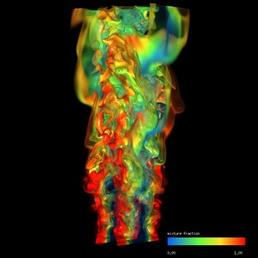Stratified combustion physics and modelling
- Started
- 15th July 2007
- Investigators
- Edward Richardson

Turbulent stratified jet flame, with heat release surfaces coloured by mixture fraction (a measure of the fuel-air ratio). Volume rendering by Hongfeng Yu, Sandia National Laboratories.
Stratified combustion occurs when the fuel-air mixture is partly, but not perfectly, mixed before combustion. In advanced power and propulsion systems, stratified combustion occurs where designers use very lean or low temperature premixed combustion to achieve low nitrous oxide emissions, and then add local pockets of fuel-rich mixture in order to achieve acceptable flame stability and ignitability.
Direct Numerical Simulations of turbulent combustion (with 300 Million grid points), employing realistic models for combustion chemistry and molecular transport (27 reactive scalars), are used to provide full-resolution data in which to investigate the fundamental impact, and practical modelling, for effects of fuel-air stratification.
This project is a collaboration with Sandia National Laboratories (California), with computing resources provided by the NCCS(ORNL), and NERSC(LBNL) in the USA.
Categories
Physical Systems and Engineering simulation: CFD, Combustion, Complex fluids, Energy, Turbulence
Algorithms and computational methods: Finite differences
Programming languages and libraries: Fortran, MPI
Computational platforms: Jaguar
Transdisciplinary tags: Scientific Computing